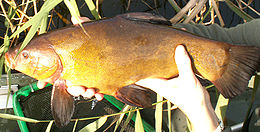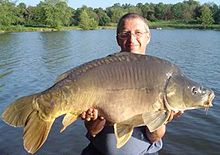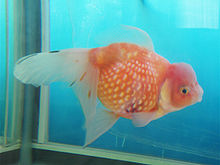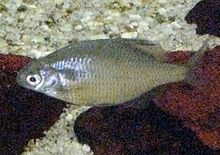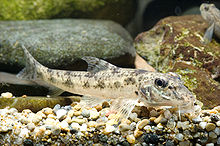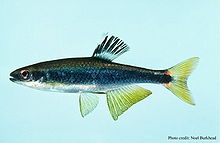- Cyprinidae
-
Cyprinids
Temporal range: Eocene - PresentThe Tench (Tinca tinca) is of unclear affiliations and often placed in a subfamily of its own Scientific classification Kingdom: Animalia Phylum: Chordata Superclass: Osteichthyes Class: Actinopterygii Subclass: Neopterygii Infraclass: Teleostei Superorder: Ostariophysi Order: Cypriniformes Superfamily: Cyprinioidea Family: Cyprinidae Subfamilies Acheilognathinae
Cultrinae
Cyprininae
Danioninae
Gobioninae
Hypophthalmichthyinae
Labeoninae (disputed)
Leuciscinae
Psilorhynchinae
Rasborinae (polyphyletic?)
Squaliobarbinae (disputed)
Tincinae
and see textThe family Cyprinidae, from the Ancient Greek kyprînos (κυπρῖνος, "carp"), consists of the carps, the true minnows, and their relatives (for example, the barbs and barbels). Commonly called the carp family or the minnow family, its members are also known as cyprinids. It is the largest family of fresh-water fish, with over 2,400 species in about 220 genera. The family belongs to the order Cypriniformes, of whose genera and species the cyprinids make up two-thirds.[1]
Contents
Description
 Giant Barbs (Catlocarpio siamensis) are the largest members of this family
Giant Barbs (Catlocarpio siamensis) are the largest members of this family
Cyprinids are stomachless fish with toothless jaws. Even so, food can be effectively chewed by the gill rakers of the specialized last gill bow. These pharyngeal teeth allow the fish to make chewing motions against a chewing plate formed by a procession of the skull. The pharyngheal teeth are species specific and are used by specialists to determine the species. Strong pharyncheal teeth allow fish like the common carp and ide to eat hard baits like snails and bivalves.
Hearing is a well-developed sense, since the cyprinds have the Weberian organ, three specialized vertebra processions that transfer motion of the gas bladder to the inner ear. This construction is also used to observe motion of the gas bladder due to atmospheric conditions or depth changes. The cyprinids are physostomes because the pneumatic duct is retained in adult stages and the fish are able to gulp air to fill the gas bladder or they can dispose excess gas to the gut.
The fish in this family are native to North America, Africa, and Eurasia. The largest cyprinid in this family is the Giant Barb (Catlocarpio siamensis), which may grow up to 3 metres (9.8 ft). The largest North American species is the Colorado Pikeminnow (Ptychocheilus lucius), of which individuals up to 6 feet (1.8 m) long and weighing over 100 pounds (45 kg) have been recorded.
On the other hand, many species are smaller than 5 centimetres (2.0 in). As of 2008, the smallest known freshwater fish is a cypriniform, Danionella translucida, reaching 12 millimetres (0.47 in) at the longest.[2] All fish in this family are egg-layers and most do not guard their eggs, however, there are a few species that build nests and/or guard the eggs. The bitterling-like cyprinids (Acheilognathinae) are notable for depositing their eggs in bivalve molluscs, where the young grow up until able to fend for themselves.
Most cyprinids feed mainly on invertebrates and vegetation probably due to the lack of teeth and stomach, but some species like the Asp specialize in fish. Many species ide, common rudd will eat small fish however when reaching a certain size. Even small species like the moderlieschen eat larvae of the common frog in artificial circumstances.
Some fishes, such as the grass carp, are specialized in eating vegetation, some, such as the common nase, eat algae from hard surfaces, some, such as the black carp, specialize in snails, and some, such as the silver carp, are specialized filter feeders. For this reason, they are often introduced as a management tool to control various factors in the aquatic environment, such as aquatic vegetation and diseases transmitted by snails.
Relationship with humans
Cyprinids are highly important food fish; they are fished and farmed across Eurasia. In land-locked countries in particular, cyprinids are often the major species of fish eaten because they make the largest part of biomass in most water types except for fast flowing rivers. In non-landlocked countries they are not very much appreciated due to the high number of bones. In Eastern Europe they are often prepared with traditional methods like drying and salting. The prevalence of inexpensive frozen fish products made this less important now than it was in earlier times. Nonetheless, in certain places they remain popular for food as well as recreational fishing, and have been deliberately stocked in ponds and lakes for centuries for this reason.[3]
Cyprinids are popular for angling especially for match fishing (due to their dominance in biomass and numbers) and fishing for common carp because of its size and strength.
Several cyprinids have been introduced to waters outside their natural range to provide food, sport, or biological control for some pest species. The Common Carp (Cyprinus carpio) and the Grass Carp (Ctenopharyngodon idella) are the most important of these, for example in Florida. In some cases, these have become invasive species that compete with native fishes or disrupt the environment. Carp in particular can stir up sediment, reducing the clarity of the water and making it difficult for plants to grow.[4]
Numerous cyprinids have become important in the aquarium hobby, most famously the Goldfish, which was bred in China from the Prussian Carp (Carassius (auratus) gibelio). First imported into Europe around 1728, it was much fancied by Chinese nobility as early as 1150 AD and after it arrived there in 1502, also in Japan. In the latter country, from the 18th century onwards the Common Carp was bred into the ornamental variety known as koi – or more accurately nishikigoi (錦鯉), as koi (鯉) simply means "Common Carp" in Japanese.
Other popular aquarium cyprinids include danionins, rasborines and true barbs.[5] Larger species are bred by the thousands in outdoor ponds, particularly in Southeast Asia, and trade in these aquarium fishes is of considerable commercial importance. The small rasborines and danionines are perhaps only rivalled by characids and poecilid livebearers in their popularity for community aquaria.
One particular species of these small and undemanding danionines is the Zebrafish (Danio rerio). It has become the standard model species for studying developmental genetics of vertebrates, in particular fish.[6]
Habitat destruction and other causes have reduced the wild stocks of several cyprinids to dangerously low levels; some are already entirely extinct. In particular, Leuciscinae from southwestern North America have been hit hard by pollution and unsustainable water use in the early-mid 20th century; most globally extinct Cypriniformes species are in fact Leuciscinae from the southwestern United States and northern Mexico.
Systematics
The massive diversity of cyprinids has so far made it difficult to resolve their phylogeny in sufficient detail to make assignment to subfamilies more than tentative in many cases. It is obvious that some distinct lineages exist – for example, Cultrinae and Leuciscinae, regardless of their exact delimitation, are rather close relatives and stand apart from Cyprininae –, but the overall systematics and taxonomy of the Cyprinidae remain a subject of considerable debate. A large number of genera are incertae sedis, too equivocal in their traits and/or too little-studied to permit assignment to a particular subfamily with any certainty.[7]
Part of the solution seems that the delicate rasborines are the core group, consisting of minor lineages that have not shifted far from their evolutionary niche, or have co-evolved, for millions of years. These are among the most basal lineages of living cyprinids. Other "rasborines" are apparently distributed across the diverse lineages of the family.[8]
The validity and circumscription of proposed subfamilies like Labeoninae or Squaliobarbinae also remains doubtful, although the latter do appear to correspond to a distinct lineage. The sometimes-seen grouping of the large-headed carps (Hypophthalmichthyinae) with Xenocypris, on the other hand, seems quite in error. More likely, the latter are part of the Cultrinae.[8]
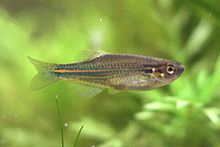 Blue Danio (Danio kerri: Danioninae)
Blue Danio (Danio kerri: Danioninae)
 Silver Carp (Hypophthalmichthys molitrix: Hypophthalmichthyinae)
Silver Carp (Hypophthalmichthys molitrix: Hypophthalmichthyinae) Rohu (Labeo rohita) of the disputed Labeoninae)
Rohu (Labeo rohita) of the disputed Labeoninae)
The entirely paraphyletic "Barbinae" and the disputed Labeoninae might be better treated as part of the Cyprininae, forming a close-knit group whose internal relationships are still little known. The small African "barbs" do not belong in Barbus sensu stricto – indeed, they are as distant from the typical barbels and the typical carps (Cyprinus) as these are from Garra (which is placed in the Labeoninae by most who accept the latter as distinct) and thus might form another as of yet unnamed subfamily. However, as noted above, how various minor lineages tie into this has not yet been resolved; therefore such a radical move, though reasonable, is probably premature.[9]
The Tench (Tinca tinca), a significant food species farmed in western Eurasia in large numbers, is unusual. It is most often grouped with the Leuciscinae, but even when these were rather loosely circumscribed, it always stood apart. A cladistic analysis of DNA sequence data of the S7 ribosomal protein intron 1 supports the view that it is distinct enough to constitute a monotypic subfamily. It also suggests that it may be closer to the small East Asian Aphyocypris, Hemigrammocypris, and Yaoshanicus. They would have diverged roughly at the same time from cyprinids of east-central Asia, perhaps as a result of the Alpide orogeny that vastly changed the topography of that region in the late Paleogene, when their divergence presumably occurred.[10]
Subfamilies & Genera
Subfamily Acheilognathinae – bitterling-like cyprinids
- Acanthorhodeus (Spiny bitterlings)
- Acheilognathus (Bitterlings)
- Rhodeus (Bitterlings)
- Tanakia (Bitterlings)
Subfamily Barbinae (Barbs)
- Acrossocheilus
- Balantiocheilos
- Barbus (typical barbels and barbs)
- Carasobarbus
- Clypeobarbus
- Diptychus – "snowtrouts"
- Luciobarbus
- Mesopotamichthys
- Oreichthys
- Ospatulus
- Pseudobarbus – redfins
- Puntius – spotted barbs
- Schizothorax – marinkas, "snowtrouts"
- Sinocyclocheilus – golden-line fish
- Spratellicypris
Subfamily Cultrinae
- Anabarilius
- Chanodichthys
- Culter
- Cultrichthys
- Hemiculter (sharpbellies)
- Ischikauia
- Megalobrama
- Parabramis – White Amur Bream
- Sinibrama
- Toxabramis
Subfamily Cyprininae (true carps)
Subfamily Danioninae – danionins
- Amblypharyngodon (carplets)
- Barilius
- Betadevario
- Boraras (rasboras)
- Brevibora (rasboras)
- Chela
- Danio (danios)
- Danionella
- Devario
- Esomus (flying barbs)
- Horadandia
- Inlecypris
- Kottelatia
- Laubuca
- Leptocypris
- Luciosoma
- Malayochela
- Mesobola
- Microdevario
- Microrasbora
- Nematabramis
- Neobola
- Opsaridium
- Opsarius
- Paedocypris
- Pectenocypris
- Raiamas
- Rasboroides
- Salmophasia – razorbelly minnows
- Securicula
- Sundadanio
- Trigonostigma
Subfamily Gobioninae – true gudgeons and relatives (including Gobiobotinae)
- Coreius
- Gnathopogon
- Gobio – typical gudgeons
- Gobiobotia
- Gobiocypris
- Hemibarbus (steeds)
- Microphysogobio
- Pseudogobio
- Pseudorasbora
- Romanogobio
- Sarcocheilichthys
- Saurogobio
- Squalidus
Subfamily Labeoninae (including Garrinae; might belong in Cyprininae)
- Akrokolioplax
- Bangana
- Cirrhinus (mud carps)
- Cophecheilus
- Crossocheilus
- Discocheilus
- Discogobio
- Garra
- Hongshuia
- Labeo – Labeos
- Labeobarbus – yellowfish
- Labiobarbus
- Osteochilus
- Parasinilabeo
- Protolabeo
- Pseudocrossocheilus
- Pseudogyrinocheilus
- Ptychidio
- Qianlabeo
- Rectoris
- Semilabeo
- Sinocrossocheilus
Subfamily Leptobarbinae
 Chinese Minnow (Rhynchocypris oxycephalus), a minnow related to some North American daces
Chinese Minnow (Rhynchocypris oxycephalus), a minnow related to some North American daces
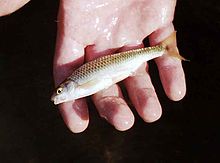 Rutilus rubilio a European roach
Rutilus rubilio a European roach
Subfamily Leuciscinae – chubs, daces, true minnows, roaches, shiners and so on.
- Achondrostoma
- Acrocheilus (Chiselmouth)
- Agosia
- Alburnus (bleaks)
- Algansea (chubs)
- Aztecula (Aztec shiner)
- Campostoma (stonerollers)
- Chondrostoma (typical nases)
- Chrosomus (daces)
- Clinostomus (redside daces)
- Codoma
- Couesius (the Lake Chub)
- Cyprinella – satinfin shiners
- Delminichthys
- Dionda – desert minnows
- Eremichthys – Desert Dace
- Ericymba – the Longjaw Minnow
- Erimonax
- Erimystax – slender chubs
- †Evarra – Mexican daces
- Exoglossum – cutlips minnows
- Gila – western chubs (including Siphateles)
- Hemitremia – Flame Chub
- Hesperoleucus – California Roach
- Hybognathus – silvery minnows
- Hybopsis – bigeye chubs
- Iberochondrostoma
- Iotichthys – Least Chub
- Lavinia – Hitch
- Lepidomeda – spinedaces
- Leuciscus – Eurasian daces
- Luxilus – highscale shiners
- Lythrurus – finescale shiners
- Macrhybopsis – blacktail chubs
- Margariscus – Daces
- Meda – Spikedace
- Moapa – Moapa Dace
- Mylocheilus – peamouth
- Mylopharodon – hardheads
- Nocomis – hornyhead chubs
- Notemigonus – Golden Shiner
- Notropis – eastern shiners
- Opsopoeodus – pugnose minnow
- Oregonichthys – Oregon chubs
- Orthodon – Sacramento Blackfish
- Parachondrostoma
- Pelasgus
- Pelecus – Ziege, Sabre Carp
- Petroleuciscus – Ponto-Caspian chubs and daces
- Phenacobius – suckermouth minnows
- Phoxinellus
- Phoxinus – Eurasian minnows and daces
- Pimephales – bluntnose minnows
- Plagopterus – Woundfin
- Platygobio – flathead chub
- Pogonichthys – splittails
- Protochondrostoma
- Pseudochondrostoma
- Pseudophoxinus
- Pteronotropis – flagfin shiners
- Ptychocheilus – pikeminnows
- Relictus – Relict Dace
- Rhinichthys – riffle daces (including Tiaroga)
- Rhynchocypris – Eurasian minnows
- Richardsonius – redside shiners
- Semotilus – creek chubs
- Snyderichthys – Leatherside Chub
- Squalius – European chubs
- Telestes
- Tribolodon
- Yuriria
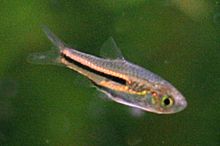 Trigonostigma somphongsi ("Rasborinae", probably not too distant from the Blue Danio above)
Trigonostigma somphongsi ("Rasborinae", probably not too distant from the Blue Danio above)
 Black Carp (Mylopharyngodon piceus: Squaliobarbinae)
Black Carp (Mylopharyngodon piceus: Squaliobarbinae)
Subfamily Rasborinae – rasborines
- Aphyocypris
- Aspidoparia
- Engraulicypris (the Lake Sardine)
- Oxygaster
- Rasbora
- Rasbosoma
- Rastrineobola – Silver Cyprinid
- Thryssocypris
- Trigonopoma
Subfamily Squaliobarbinae
- Ctenopharyngodon – the Grass Carp
- Squaliobarbus
Subfamily Tincinae
- Tanichthys – cardinal minnows
- Tinca – Tench
Subfamily Xenocyprinae
- Distoechodon
- Hypophthalmichthys – bighead carps
- Plagiognathops
- Pseudobrama
- Xenocypris
- Aaptosyax (Giant salmon carp)
- Abbottina (False gudgeons)
- Abramis (Common bream)
- Acanthalburnus (Bleaks)
- Acanthobrama (Bleaks)
- Acanthogobio
- Acapoeta
- Albulichthys
- Alburnoides (Bleaks)
- Amblyrhynchichthys
- Anaecypris
- Ancherythroculter
- Anchicyclocheilus
- Araiocypris
- Aspiolucius
- Aspiorhynchus
- Aspius
- Atrilinea
- Aulopyge (Dalmatian Barbelgudgeon)
- Ballerus (Breams)
- Barbichthys
- Barbodes
- Barboides
- Barbonymus (Tinfoil barbs)
- Barbopsis (the Somalian Blind Barb)
- Belligobio
- Biwia
- Blicca (Silver Bream)
- Caecobarbus (the Congo blind barb)
- Caecocypris
- Candidia
- Capoeta (Khramulyas)
- Capoetobrama
- Catla (the Catla) (Note: some authorities consider this species to belong in the genus Gibelion)
- Catlocarpio
- Chagunius
- Chelaethiops
- Chuanchia
- Coptostomabarbus
- Coreoleuciscus (the Korean Splendid Dace)
- Cosmochilus
- Cyclocheilichthys
- Cyprinion
- Diplocheilichthys
- Discherodontus
- Discolabeo
- Eirmotus
- Elopichthys
- Epalzeorhynchos
- Folifer
- Gymnocypris
- Gymnodanio
- Gymnodiptychus
- Hainania
- Hampala
- Hemiculterella
- Hemigrammocapoeta
- Hemigrammocypris (close to Aphyocypris?)
- Henicorhynchus
- Herzensteinia
- Horalabiosa
- Huigobio
- Hypselobarbus
- Hypsibarbus
- Iberocypris
- Iranocypris – Iran cave barb
- Kalimantania
- Kosswigobarbus
- Ladigesocypris
- Ladislavia
- Laocypris
- Lepidopygopsis
- Leucalburnus
- Leucaspius – Moderlieschen
- Linichthys
- Lobocheilos
- Longanalus
- Longiculter
- Luciobrama
- Luciocyprinus
- Macrochirichthys – Long Pectoral-fin Minnow
- Megarasbora
- Mekongina
- Mesogobio
- Metzia
- Mylopharyngodon – Black Carp
- Mystacoleucus
- Naziritor – Zhobi mahseers
- Neobarynotus
- Neolissochilus – "mahseers"
- Nicholsicypris
- Nipponocypris
- Ochetobius
- Onychostoma
- Opsariichthys
- Oreoleuciscus
- Osteobrama
- Osteochilichthys
- Oxygymnocypris
- Pachychilon
- Paracanthobrama
- Parachela
- Paracrossochilus
- Paralaubuca
- Paraleucogobio
- Parapsilorhynchus
- Pararasbora
- Pararhinichthys – Cheat Minnow
- Parasikukia
- Paraspinibarbus
- Parasqualidus
- Parator
- Parazacco
- Percocypris
- Phreatichthys – Somalian Cavefish
- Placogobio
- Platypharodon
- Platysmacheilus
- Pogobrama
- Poropuntius
- Probarbus
- Procypris
- Prolabeo
- Prolabeops
- Pseudaspius
- Pseudobrama
- Pseudohemiculter
- Pseudolaubuca
- Pseudopungtungia
- Ptychobarbus
- Pungtungia
- Puntioplites
- Rasborichthys
- Rhinogobio
- Rohtee – Vatani rohtee
- Rohteichthys
- Rostrogobio
- Rutilus – roaches
- Sanagia
- Sawbwa – Sawbwa Barb
- Scaphiodonichthys
- Scaphognathops
- Scardinius – rudds
- Schismatorhynchos
- Schizocypris – "snowtrouts"
- Schizopyge – "snowtrouts"
- Schizopygopsis – "snowtrouts"
- Semiplotus
- Sikukia
- Sinilabeo
- Spinibarbus
- †Stypodon – Stumptooth minnow
- Tampichthys
- Thynnichthys
- Tor – "mahseers"
- Troglocyclocheilus
- Tropidophoxinellus
- Typhlobarbus
- Typhlogarra – Iraq blind barb
- Varicorhinus
- Vimba
- Xenobarbus
- Xenocyprioides
- Xenophysogobio
- Yaoshanicus
- Zacco
Unlike most fish species, cyprinid fish generally increase in abundance in eutrophic lakes. Here, they contribute towards positive feedback as they are efficient at eating zooplankton which would otherwise graze on the algae, reducing its abundance.
See also
Footnotes
- ^ FishBase (2004), Nelson (2006), dictionary.com [2009]
- ^ Nelson (2006)
- ^ Magri MacMahon (1946): pp.149-152
- ^ GSMFC (2005), FFWCC [2008]
- ^ Riehl & Baensch (1996): p.410
- ^ Helfman et al. (1997): p.228
- ^ de Graaf et al. (2007), He et al. (2008a,b)
- ^ a b He et al. (2008a)
- ^ Howes (1991), de Graaf et al. (2007), IUCN (2009)
- ^ He et al. (2008b)
References
- De Graaf, M.; Megens, H. J.; Samallo, J.; Sibbing, F. A. (2007). "Evolutionary origin of Lake Tana's (Ethiopia) small Barbus species: indications of rapid ecological divergence and speciation". Animal Biology 57: 39. doi:10.1163/157075607780002069.
- dictionary.com [2009]: Cyprinid. Retrieved 2009-SEP-25.
- Froese, Rainer, and Daniel Pauly, eds. (2011). "Cyprinidae" in FishBase. August 2011 version.
- Florida Fish and Wildlife Conservation Commission (FFWCC) (2006): Florida's Exotic Freshwater Fishes. Retrieved 2007-03-05.
- Gulf States Marine Fisheries Commission (GSMFC) (2005): Cyprinus carpio (Linnaeus, 1758). Version of 2005-08-03. Retrieved 2007-05-03.
- He, S.; Mayden, R.; Wang, X.; Wang, W.; Tang, K.; Chen, W.; Chen, Y. (2008). "Molecular phylogenetics of the family Cyprinidae (Actinopterygii: Cypriniformes) as evidenced by sequence variation in the first intron of S7 ribosomal protein-coding gene: Further evidence from a nuclear gene of the systematic chaos in the family". Molecular Phylogenetics and Evolution 46 (3): 818. doi:10.1016/j.ympev.2007.06.001. PMID 18203625.
- He, S.; Gu, X.; Mayden, R. L.; Chen, W. J.; Conway, K. W.; Chen, Y. (2008). "Phylogenetic position of the enigmatic genus Psilorhynchus (Ostariophysi: Cypriniformes): Evidence from the mitochondrial genome". Molecular Phylogenetics and Evolution 47 (1): 419. doi:10.1016/j.ympev.2007.10.012. PMID 18053751.
- Helfman, Gene (1997). The Diversity of Fishes. Oxford: Blackwell Science. ISBN 0865422567.
- Howes, G.J. (1991): Systematics and biogeography: an overview. In: Winfield, I.J. & Nelson, J.S. (eds.): Biology of Cyprinids: 1–33. Chapman and Hall Ltd., London.
- International Union for the Conservation of Nature and Natural Resources (IUCN) (2009): 2009 IUCN Red List of Threatened Species. Version 2009.1. Retrieved 2009-SEP-20.
- Magri MacMahon, A.F. (1946): Fishlore. Pelican Books.
- Nelson, Joseph (2006). Fishes of the World. Chichester: John Wiley & Sons. ISBN 0471250317.
- Riehl, Rudiger (1996). Aquarium Atlas. Voyageur Press (MN). ISBN 3882440503.
External links
Categories:- Fish of North America
- Fish of Asia
- Fish of Europe
- Fish of Africa
- Cypriniformes
- Cyprinidae
Wikimedia Foundation. 2010.

